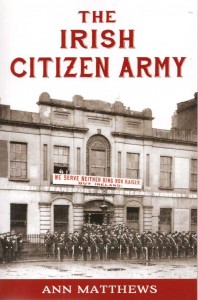The Irish Citizen Army
Published in Book Reviews, Issue 6 (November/December 2014), Reviews, Volume 22ANN MATTHEWS
Mercier Press
?14.99
ISBN 9781781171592
It may be a strange twist of historiography that the Irish Citizen Army has not attracted as much scholarly attention as the Irish Volunteers, the UVF or the ITGWU. It may also have been the case that the source material to sustain a full-length scholarly monograph was not available. Seán O’Casey (1919) and Frank Robbins (1977) have told the story of the Army from their own perspectives, while R.M. Fox produced an extensive narrative account based mainly on the oral testimonies of surviving members in 1943.
The availability of the Bureau of Military History (BMH) Witness Statements has lessened the source scarcity somewhat. There are also limited documentary sources scattered across personal and organisational papers related to the labour and radical political movements of the early twentieth century. Add to this the fact that many historians have written in detail about certain aspects of the Citizen Army and a full-length scholarly treatment looks like a slightly less onerous task.
Ann Matthews is not the first to attempt a wide-ranging study of the ICA. Kevin Morley’s self-published e-book, A descriptive history of the Irish Citizen Army, appeared in 2009. This is something that perhaps Matthews might have mentioned in her discussion of the historiography, regardless of the merits of Morley’s contribution. Matthews laments the fact that the BMH Witness Statements hold ‘relatively little’ on the ICA and states that without the uncatalogued John Hanratty papers, held at Kilmainham Gaol, ‘the story of the ICA would still languish in much speculation and hearsay’ (p. 9). Given that these papers are uncatalogued and not publicly available for consultation, a description of what is actually contained in them would have been welcome. Without such commentary, the reader is left to assume that they contain the written materials used by R.M. Fox in 1943 (Hanratty was the leading figure in a committee that collected the materials for Fox’s book, p. 186).
The introduction follows the provenance of the ICA in the ITGWU and provides a concise and informative history of the union’s development from 1909 to 1913. It traces the origins of the ICA to the first week of the Dublin Lockout and the formation of an unofficial workers’ defence group by rank-and-file members of the union. Dublin, however, has less claim to the origins of the workers’ militia idea than might be assumed. Similar groups existed during ITGWU-led strikes in Cork (1909) and Wexford (1911). The origins of the ICA might even be traced back to the existence of a workers’ militia during the Belfast dock strike of 1907. The rank-and-file genesis narrative should also be qualified by reference to Jim Larkin’s repeated calls for ITGWU members to take up arms and defend themselves throughout 1913.
The early chapters provide a good narrative account of the ICA’s development. Matthews brings information together from a selection of secondary sources, BMH statements, the ITGWU newspapers and some other primary sources. Mention is made of the ICA’s development in relation to the Irish Volunteers at this point of the book, although analysis of the reasons for the vastly different trajectories of the two militias would have been welcome. Why, for instance, did the ICA have little success in its attempts to recruit members outside Dublin?
The role and fate of the ICA in the planning, course and aftermath of the Easter Rising are given four detailed chapters. There is, however, a lot of information about the Rising generally in these chapters (especially Chapter 5). It is difficult to speculate on whether or not Matthews would have been justified in assuming a good knowledge of the Rising on the part of the book’s readers. Such assumptions might well have had a detrimental effect on what is an exciting tale of the Rising and the ICA’s role in it.
Matthews’s approach to oral testimony demonstrates a lack of consistency. A number of witness statements are rightly questioned. Much less rigour is employed, however, when it comes to the question of Constance Markievicz’s character and behaviour during her court martial in the wake of the 1916 Rising. A passage from the prosecuting counsel’s memoir is quoted in full and without question. In this Markievicz is described as having pleaded for her life—behaviour that disgusted the memoirist. Matthews does not note that the memoir was written decades later (as she does with a number of witness statements), nor does she acknowledge the existence of a transcript of the court martial proceedings that completely contradicts the memoir (p. 143).
Ann Matthews should be highly commended for writing this book. The dearth of primary source material will not have made the process an easy task, especially for the post-1916 period. Brian Hanley’s work on the ICA after 1916 will have been very useful, and the structure of his Saothar article (2003) on the topic is reflected here. Unfortunately, however, the period of inactivity from the end of the Civil War (1923) until the emergence of the Republican Congress (1934) is allowed only two sentences. The lengthy appendices, providing comprehensive membership lists, will be of great use to those researching the Citizen Army in years to come. The book is an enjoyable read, but I suspect that it’s not the last we’ll hear about the ICA.

















